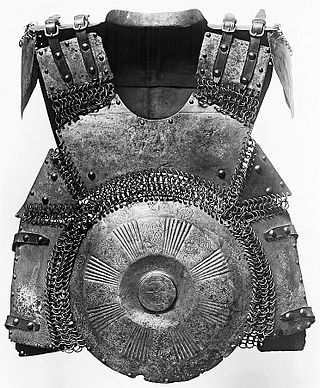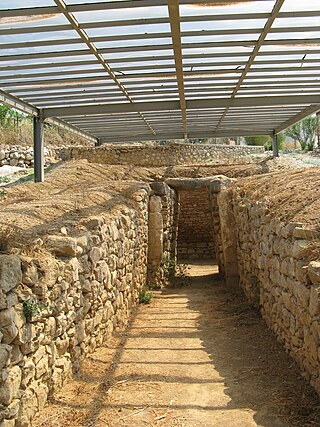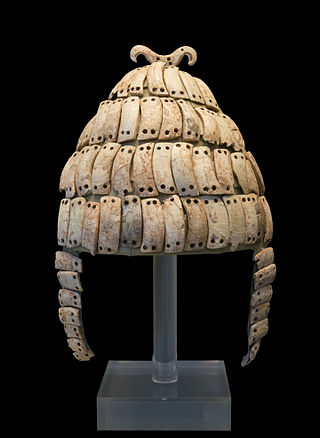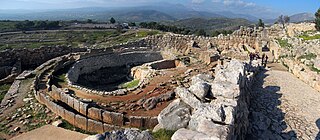
The Dendra panoply or Dendra armour is an example of Mycenaean-era panoply (full-body armor) made of bronze plates uncovered in the village of Dendra in the Argolid, Greece.

The Dendra panoply or Dendra armour is an example of Mycenaean-era panoply (full-body armor) made of bronze plates uncovered in the village of Dendra in the Argolid, Greece.

Several elements of body armour (body cuirass, shoulder guards, breast plates and lower protection plates) from the late Mycenaean period have been found at Thebes, some bronze bands have been also found at Mycenae and Phaistos. [2] Bronze scales were found at Mycenae and Troy; scale armour, the oldest form of metal body armor, was used widely throughout the eastern Mediterranean and the Near East. In May 1960 [3] Swedish archaeologists discovered the earliest example of a beaten bronze cuirass at Dendra, dated at the end of the fifteenth century BC. [4] It forms part of the Late Helladic (LHIIIa) Dendra Panoply, which consists of fifteen separate pieces of bronze sheet, held together with leather thongs, that encased the wearer from neck to knees. [5] The panoply includes both greaves and lower arm-guards. The arm-guard is unique but greaves, probably made of linen, are often depicted in late Mycenaean art. The few bronze examples that have been found only covered the shins and may have been worn over linen ones, as much for show of status Diane Fortenberry has suggested, [6] as for protection. Although we have only this one complete panoply to date, armor of similar type appears as an ideogram on Linear B tablets from Knossos (Sc series), Pylos (Sh series) and Tiryns (Si series). [7]
The panoply's cuirass consists of two pieces, for the chest and back. These are joined on the left side by a hinge. There is a bronze loop on the right side of the front-plate and a similar loop on each shoulder. Large shoulder-guards fit over the cuirass. Two triangular plates are attached to the shoulder-guards and gave protection to the wearer's armpits when his arms were in the raised position. There is also a deep neck-guard. The Linear B ideogram depicting armour of this type makes the neck-guard clearly discernible, and protection by a high bronze collar was a typical feature of Near Eastern body armour. Three pairs of curved plates hang from the waist to protect the groin and the thighs. All these pieces are made of beaten bronze sheet and are backed with leather and loosely fastened by ox-hide thongs to allow some degree of movement. The complete panoply thus forms a cumbersome tubular suit of armour, which fully protects the neck and torso, and extends down to the knees. It appears that lower arm-guards and a set of greaves further protected the warrior, all made of bronze, as fragments of these were also found in the grave at Dendra. Slivers of boars' tusks were also discovered, which once made up a boars'-tusk helmet.
The figures on the Warrior Vase (Mycenae, ca 1200 BC, National Archaeological Museum, Athens) [8] are wearing body armor. However, this armor is different. It may be either an embossed waist-length leather corslet with a fringed leather apron that reaches to mid-thigh and possible shoulder-guards, very much like that worn by the Peoples of the Sea depicted on the mortuary temple of Ramesses III (died c. 1155 BC) at Medinet Habu, Lower Egypt, or, alternatively, the body armour may be a 'bell' corselet of beaten bronze sheet, a type also found in central Europe at that time.
The panoply has been the subject of extensive academic study and experimental research. While many scholars have discussed its functionality, [9] significant experimental investigations have also been conducted. In 1988, Diana Wardle, [10] using a replica crafted by students at the Bournville College of Art, Birmingham (now part of Birmingham City University), made initial findings regarding its practical use. In 2012, professor Barry Molloy, [11] utilizing a different replica, contributed important insights into the kinematics of the armor. In 2018, archaeologist Spyros Bakas, [12] through a meticulous reconstruction of the panoply, provided crucial information on its distinctive features and the anatomy of its components, while also addressing the operational capabilities of the warrior. Most recently, in 2024, researchers from the University of Thessaly, led by professor Andreas Flouris, using Wardle's 1980s replica, added new conclusions on the ergonomics and kinematics of the warrior wearing the armor, showing that "[a] group of special armed-forces personnel wearing a replica of the Dendra armour were able to complete an 11-hour simulated Late Bronze Age combat protocol that we developed from a series of studies based on the available evidence". [1] This research indicates that the armour was perfectly suited to use in battle, not simply ceremonial as originally assumed.
{{cite book}}: CS1 maint: location missing publisher (link)
Aegean civilization is a general term for the Bronze Age civilizations of Greece around the Aegean Sea. There are three distinct but communicating and interacting geographic regions covered by this term: Crete, the Cyclades and the Greek mainland. Crete is associated with the Minoan civilization from the Early Bronze Age. The Cycladic civilization converges with the mainland during the Early Helladic ("Minyan") period and with Crete in the Middle Minoan period. From c. 1450 BC, the Greek Mycenaean civilization spreads to Crete, probably by military conquest. The earlier Aegean farming populations of Neolithic Greece brought agriculture westward into Europe before 5,000 BC.

The lorica segmentata, also called lorica lamminata, or banded armour is a type of personal armour that was used by soldiers of the Roman army, consisting of metal strips fashioned into circular bands, fastened to internal leather straps.

A cuirass is a piece of armour that covers the torso, formed of one or more pieces of metal or other rigid material. The word probably originates from the original material, leather, from the French cuirace and Latin word coriacea. The use of the term "cuirass" generally refers to both the breastplate and the backplate pieces; whereas a breastplate only protects the front, a cuirass protects both the front and the back of the wearer.

Plate armour is a historical type of personal body armour made from bronze, iron, or steel plates, culminating in the iconic suit of armour entirely encasing the wearer. Full plate steel armour developed in Europe during the Late Middle Ages, especially in the context of the Hundred Years' War, from the coat of plates worn over mail suits during the 14th century.

Mycenaean Greece was the last phase of the Bronze Age in ancient Greece, spanning the period from approximately 1750 to 1050 BC. It represents the first advanced and distinctively Greek civilization in mainland Greece with its palatial states, urban organization, works of art, and writing system. The Mycenaeans were mainland Greek peoples who were likely stimulated by their contact with insular Minoan Crete and other Mediterranean cultures to develop a more sophisticated sociopolitical culture of their own. The most prominent site was Mycenae, after which the culture of this era is named. Other centers of power that emerged included Pylos, Tiryns, and Midea in the Peloponnese, Orchomenos, Thebes, and Athens in Central Greece, and Iolcos in Thessaly. Mycenaean settlements also appeared in Epirus, Macedonia, on islands in the Aegean Sea, on the south-west coast of Asia Minor, and on Cyprus, while Mycenaean-influenced settlements appeared in the Levant and Italy.

Lamellar armour is a type of body armour, made from small rectangular plates of iron or steel, leather (rawhide), bone, or bronze laced into horizontal rows. Lamellar armour was used over a wide range of time periods in Central Asia, Eastern Asia, Western Asia, and Eastern Europe. The earliest evidence for lamellar armour comes from sculpted artwork of the Neo-Assyrian Empire in the Near East.

A greave or jambeau is a piece of armor that protects the leg.

Scale armour is an early form of armour consisting of many individual small armour scales (plates) of various shapes attached to each other and to a backing of cloth or leather in overlapping rows. Scale armour was worn by warriors of many different cultures as well as their horses. The material used to make the scales varied and included bronze, iron, steel, rawhide, leather, cuir bouilli, seeds, horn, or pangolin scales. The variations are primarily the result of material availability.

The linothorax is a type of upper body armor that was used throughout the ancient Mediterranean world. The term linothorax is a modern term based on the Greek λινοθώραξ, which means "wearing a breastplate of linen"; A number of ancient Greek and Latin texts from the 6th century BC to the third century AD mention θώρακες λίνεοι (Greek) or loricae linteae (Latin) which means 'linen body armour'. These are usually equated with some of the armours showed in sculptures and paintings from Italy and Greece from 575 BC onwards. Very little is known about how ancient linen armour was made. Linen armour in other cultures was usually quilted and stuffed with loose fibre or stitched together many layers thick, but it could also have been made with a special weave called twining which creates a thick, tough fabric. The theory that it was made of layers of linen glued together comes from a mistranslation of a summary of a description of medieval armour in 1869.

Pteruges refers to strip-like defences for the upper parts of limbs attached to armor in the Greco-Roman world.

Mirror armour, sometimes referred to as disc armour or as chahār-āyneh or char-aina, was a type of cuirass used mainly in Asia, the Middle East, and Eastern Europe; including India, Persia, Tibet, Russia, and the Ottoman Empire. It literally translates to "four mirrors" which is a reflection of how these pieces looked, which resembles four metal discs or rectangular armour plates. Mirror armor was used in some cultures up to the 20th century.

Dendra is a prehistoric archaeological site situated outside the village with the same name belonging to the municipality of Midea in the Argolid, Greece.

The Archaeological Museum of Nafplio is a museum in the town of Nafplio of the Argolis region in Greece. It has exhibits of the Neolithic, Chalcolithic, Helladic, Mycenaean, Classical, Hellenistic and Roman periods from all over southern Argolis. The museum is situated in the central square of Nafplion. It is housed in two floors of the old Venetian barracks.

Scholars agree that Japanese armour first appeared in the 4th century, with the discovery of the cuirass and basic helmets in graves. During the Heian period (794-1185), the unique Japanese samurai armour ō-yoroi and dō-maru appeared. The Japanese cuirass evolved into the more familiar style of body armour worn by the samurai known as the dou or dō, with the use of leather straps (nerigawa), and lacquer for weatherproofing. Leather and/or iron scales were also used to construct samurai armours, with leather and eventually silk lace used to connect the individual scales (kozane) of these cuirasses.

Helmets using ivory from boars' tusks were known in the Mycenaean world from the 17th century BC to the 10th century BC. The helmet was made through the use of slivers of boar tusks which were attached to a leather base, padded with felt, in rows. A description of a boar's tusk helmet appears in book ten of Homer's Iliad, as Odysseus is armed for a night raid to be conducted against the Trojans.
Meriones gave Odysseus a bow, a quiver and a sword, and put a cleverly made leather helmet on his head. On the inside there was a strong lining on interwoven straps, onto which a felt cap had been sewn in. The outside was cleverly adorned all around with rows of white tusks from a shiny-toothed boar, the tusks running in alternate directions in each row.
Μηριόνης δ' Ὀδυσῆϊ δίδου βιὸν ἠδὲ φαρέτρην
καὶ ξίφος, ἀμφὶ δέ οἱ κυνέην κεφαλῆφιν ἔθηκε
ῥινοῦ ποιητήν: πολέσιν δ' ἔντοσθεν ἱμᾶσιν
ἐντέτατο στερεῶς: ἔκτοσθε δὲ λευκοὶ ὀδόντες
ἀργιόδοντος ὑὸς θαμέες ἔχον ἔνθα καὶ ἔνθαεὖ καὶ ἐπισταμένως: μέσσῃ δ' ἐνὶ πῖλος ἀρήρει.

Kikko are small iron or hardened leather, hexagon shaped armour plates used in the construction of Japanese armor worn by samurai and ashigaru of feudal Japan.

Laminar armour is an armour made from horizontal overlapping rows or bands of, usually small, solid armour plates called lames, as opposed to lamellar armour, which is made from individual armour scales laced together to form a solid-looking strip of armour. Prominent examples of such armour are lorica segmentata of Ancient Rome and certain versions of samurai armour.

In classical antiquity, the muscle cuirass, anatomical cuirass, or heroic cuirass is a type of cuirass made to fit the wearer's torso and designed to mimic an idealized male human physique. It first appears in late Archaic Greece and became widespread throughout the 5th and 4th centuries BC. Originally made from hammered bronze plate, boiled leather also came to be used. It is commonly depicted in Greek and Roman art, where it is worn by generals, emperors, and deities during periods when soldiers used other types.

Grave Circle A is a 16th-century BC royal cemetery situated to the south of the Lion Gate, the main entrance of the Bronze Age citadel of Mycenae in southern Greece. This burial complex was initially constructed outside the walls of Mycenae and ultimately enclosed in the acropolis when the fortification was extended during the 13th century BC. Grave Circle A and Grave Circle B, the latter found outside the walls of Mycenae, represents one of the significant characteristics of the early phase of the Mycenaean civilization.

The military nature of Mycenaean Greece in the Late Bronze Age is evident by the numerous weapons unearthed, warrior and combat representations in contemporary art, as well as by the preserved Greek Linear B records. The Mycenaeans invested in the development of military infrastructure with military production and logistics being supervised directly from the palatial centres.